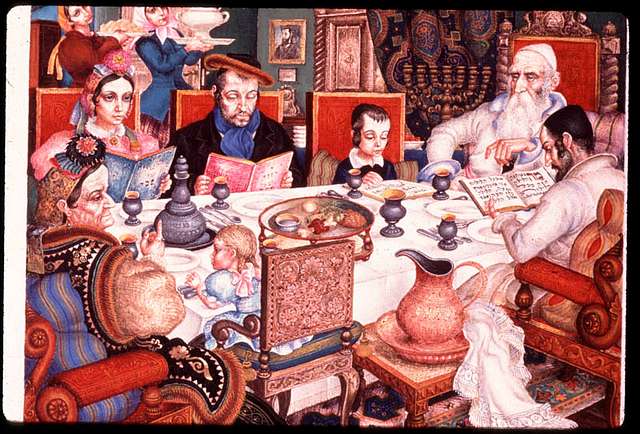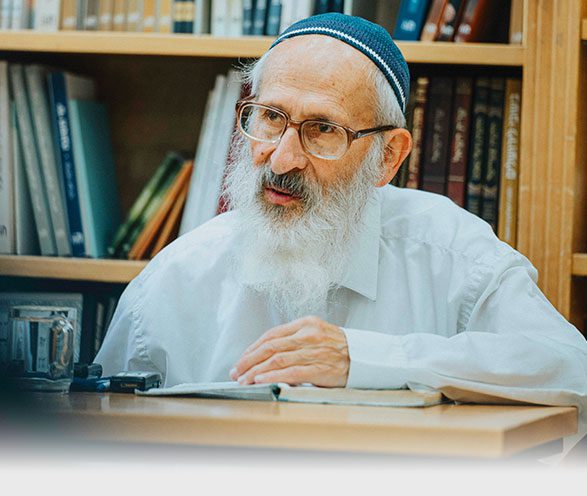by HaRav Shlomo Aviner, Head of Yeshivat Ateret Yerushalayim

Bereshit
Sections:
- Gradual Creation
- The World of Creation and the World of Action
- Human Action
- The Process of Man’s Elevation
- Man’s Elevation and the Descent of the Divine Illumination to Permeate the World
- Man’s Ascent but the Decline of the Generations
- Gradual Creation
This section deals with the Creation of the World. The world was not suddenly made in a single moment, but rather developed in stages. The transition from naught to existence is not achieved in an instant as our Sages have put it, “the world was created by ten (Divine) utterances.” But surely “with one utterance it could have been created” – so why were more used? Hashem’s capability is obviously infinite and there is no obstacle to instantaneous creation. Gradual creation is for human considerations, “in order to give goodly reward to the righteous.”[1] A world which was created with ten Divine utterances is a world that enables us to participate in the continuing process of creation. Such participation endows life with meaning. The definition of a righteous person is one whose life has significance, and the meaningful acts that he performs are called mitzvot (lehavdil,[2] existentialist philosophy also seeks meaning to life. When confronted with an existence devoid of meaning it despairs and desperately searches for significance to life).
- The World of Creation and the World of Action
The world was created through a gradual process that did not cease at the end of the seven days of Creation. Indeed, G-d suspended His actions of Creation, but the creative process continued via man. Thus, in a well-known midrash, man’s actions are considered as an extension of Hashem’s creation. The wicked Turnus Rufus once asked Rabbi Akiva: “Whose deeds are more beneficial – man’s or G-d’s?” Rabbi Akiva answered: “What are more advantageous, unprocessed ears of grain or ready-made cakes?”[3] So just as man complements Hashem’s creation in the act of circumcision, so too all of creation is enhanced by human deeds. This is the interpretations of the verse, “that G-d had created, to do.”[4] The unstated subject of the verb “to do” is man and it means that G-d has created, but man is “to do,” i.e. to continue the creation started by Hashem.[5]
There is a dispute between the schools of Hillel and Shammai as to whether heaven or earth was created first. The School of Shammai holds that the heavens preceded basing their view on the order of the words in the verse, “In the beginning G-d created heaven and earth.[6] But the School of Hillel, relying on the order of the words in another verse, “on the day that G-d made earth and heaven,”[7] holds that earth was created first. How can these apparently contradictory verses be resolved? The dispute stems from their different perspectives. The School of Shammai views the spiritual and divine aspect within matters, while the School of Hillel focuses on the physical realization of these things in this world. Thus in reality there is no contradiction. Each verse refers to a different world. In the world of “Beriyah” (creating) the heaven came first while in the world of “Asiyah” (doing) the earth came first. The world of “Beriyah” is the lofty, abstract, spiritual world.[8] The term “Beriyah” is only used regarding Hashem’s actions,[9] while “Asiyah” can also refer to man’s deeds. There are different levels in the world, some of which are mentioned in the verse, “Everyone who bears My Name whom I created (= “Beriyah”) for My glory whom I fashioned (= “Yetzirah”) and made (= “Asiyah”).”[10] In the “Kiddush Levana”[11] prayer, we say “Blessed be your Fashioner (“Yetzirah”), blessed is your Maker (“Asiyah”), blessed is your Owner (“Koneh”); blessed is your Creator (“Beniyah”).[12] Here, “Owner” is added, and this is what Pirkei Avot calls “Keriah.”[13] Thus, in the heavenly, abstract world of “Beriyah” the heavens preceded, while in our practical world of “Asiyah” the earth came first.
- Human Action
As mentioned, everything that was created by Hashem needs to “be done,”[14] i.e. to be completed. By our actions of completion, we also endow all former acts with their true significance. We can construe our deeds as if they are the extension of the tenth utterance, “Let us make man.”[15] We are finishing off the making of man by the further development and improvement of mankind. Furthermore, by our actions of completion we endow all the previous nine utterances with their true significance. The Torah relates that initially there was unformed chaos which Hashem gradually arranged. Incorrectly, we might have assumed that this process of arrangement was completed at the end of the seven days of Creation. Our Sages, however, informs us that there were two thousand years of chaos, which Hashem had only begun arranging, while we had to continue the process. Following the two thousand years of chaos came two thousand years of human elevation by the Divine instruction of the Torah. These are followed by two thousand years during which the Messiah will come. Armed with the Torah, we tackle the task of rectifying the chaos in the world and slowly but surely advance the world from Olam Ha-Tohu (The World of Chaos) to Olam Ha-Tikun (The World of Rectification).
- The Process of Man’s Elevation
The task of making order out of the chaos progressed very slowly. Man was not the epitome of ethical living. Adam Harishon[16] was an all – encompassing, universal and cosmological being that embraced the souls of all humanity. Adam Harishon is a special being. On the one hand, he is a man just like us; while on the other hand, he is a cosmological being whose soul includes the souls of all mankind. Subsequently these souls split up into individual personalities. Hence what befalls the universal Adam Harishon actually occurs to the whole of humanity. So in fact the whole of mankind has some association with sin. Kayin,[17] Lemech,[18] the generation of the deluge,[19] the generation of the dispersion[20] and the sons of G-d[21] all sinned. Every conceivable sin between man and man and between man and G-d was committed.
Technologically man was also backward. We are told that Tuval-Kayin was a maker of all copper and iron implements.[22] Man was a very feeble being and progressed, both technologically and spiritually, with many setbacks, very slowly. In fact in the ten generations between Adam Harishon and Noach, mankind[23] degenerated so badly that it was condemned to destruction by drowning. Finally Noach appeared on the scene and had a tempering effect as Hashem smelled the appeasing fragrance[24] of his offering.
In the generation of Enosh, man groped out towards the Master of the Universe but instead ended up worshipping idols. Every now and then important personalities such as Chanoch, Metushelach and others surfaced. Then, “ten generations after Noach, Avraham appeared, and received the reward of all of them.”[25] This means that the whole complicated course of history was tailored so that this gigantic personality should emerge. But that was not the end of the evolutionary process. Avraham’s son, Yishmael; and Yitzchak’s son, Esav, were not incorporated into the Nation of Israel; unlike all of the twelve, righteous sons of Yaakov who were included. But it was not a smooth progress here either. Little by little, man must progress from a spiritually primitive and coarse being, enmeshed in sin, to eventually becoming an elevated and refined creation.
- Man’s Elevation and the Descent of the Divine Illumination to Permeate the World
Man’s development is also a Divine process. “Ten and not nine”[26]– all the ten staged of Creation including the last one of “Let us create man” are all divinely and not humanly controlled. Man grows, develops and advances because the Divine illumination descends and pervades the whole of existence.
Evolution and development are well known concepts in modern thought, and have been deeply examined both in biology[27]and philosophy[28] by non-Jewish thinkers. At first sight there seems to be a contradiction between the process of atzilut and hishtalshlut[29] on the one hand, and the process of evolution and development on the other hand. The former are from “above downwards” while the latter are from “below upwards.” They are not, however, contradictory and the two notions are the very same process. The descent of the Divine illumination into the world and the ascent of man are identical. Adam Harishon’s sin (descent) caused the departure (ascent) of the Shechinah.[30] The Midrash[31] describes the reverse process how Avraham, Yitzchak, Yaakov, etc… and finally Moshe[32] by virtue of their ascent in righteousness brought the Divine Presence back down into the world. Hashem’s Divine illumination pervades the whole of reality and thus invigorates and vivifies the entire world. The greater the degree of Divine illumination in a body, the higher the level of life is in that body; ranging from inanimate objects through to vegetation, animals and upwards. The Divine illumination descends to pervade the world more and more over the years and generations and thus man correspondingly ascends more and more.
- Man’s Ascent but the Decline of the Generations
The “decline of the generations” occurs at the level of the individual. All of the individuals of earlier generations were closer to the Divine Revelation, manifested at the “Giving of the Torah”[33] at Mt. Sinai. However, at the national level, the level of the generation as a whole, there is a continual ascent.[34] This does not mean that everyone in our generation is superior to those of former generations. A distinction must be made between individual greatness and superiority of a class as a whole. It is quite feasible that an individual may be personally inferior to someone of a former generation but at the same time class-wise he outranks his counterpart of the past generation. This may be illustrated by a comparison made between a broken down car and a bicycle that functions. At the “personal” level the bicycle is better because it works. “Category-wise,” however, the broken down car surpasses the bike because it can be repaired to become a functioning car which cannot be done with the bicycle.
Every generation exceeds the previous one because holiness is cumulative.[35] A question may be posed: is each new generation greater than the previous one in the same sense that the midget on the shoulders of the giant is greater and higher up than the giant? That is, the generation is more degenerate but rides on the shoulders of all the cumulative good of former times or is the generation itself, in its very essence, superior to previous generations? The simple answer is that all the generations are inseparable. They are the same body at different stages of development. It is like the question: is a fourteen year old child bigger than he was when he was thirteen because he has had an extra piece added to him, or is he through and through bigger than the thirteen year old? The question is meaningless, because it is the very same child that has simply grown up.[36] Mankind is continually progressing. The Divine illumination that operates in the world propels all the generations onwards and upwards. While it is true that the more advanced matters become the more opportunities there are for complications to arise, the inner process of advancement and elevation nonetheless continues relentlessly.
Haftarah for Parashat Bereshit
Spiritual Blindness
[Ashekanzim: Yeshayahu 42:5-43:10
Sefardim: Yeshayahu 42:5-42:21
Yemenite Jews: Yeshayahu 42:1-42:16]
In our Haftarah, Yeshayahu is full of anger.
“Listen, deaf ones; look, blind ones, so that you can see” (18).
There is so much to see, so many miracles which Hashem performs for His Nation. One must open one’s eyes and see the natural fulfillment of the messianic prophesies that have led to the establishment of the State of Israel. We are not discussing pseudo-prophesy or retroactive prophesy, as those who ascribe to Biblical criticism explain, but the promises of Yeshayahu materializing before our very eyes. “The earlier ones have come about” – the earlier prophesies were already fulfilled – “And I relate new ones, I will let you hear them before they spring forth” (9).
To our distress, there are avowed blind people – people who recognize these prophesies but refuse to register in their minds this shining reality. Who are these blind people? “Who is blind but My servant and who is deaf as My messenger whom I sent? Who is blind as the perfect one and blind as Hashem’s servant” (19).
To be “Hashem’s servant” or “Hashem’s messenger” is one of the highest levels of involvement, requiring a special ability to integrate sterling character traits, righteousness, purity, and holiness. This obviously includes observing, out of unlimited love, Shabbat, kashrut, and all of the other mitzvoth. A person such as this is willing to sacrifice himself for the sake of Torah and we are full of respect and admiration for him.
To our dismay, however, despite his extremely high level of commitment, this religiously and spiritually righteous person is capable of being afflicted with historical blindness. He is capable of passing through powerful revolutions which occur to the Nation of Israel without noticing: “Seeing much but not observing, opening the ears but not hearing” (20).
The day will arrive, though, when “Hashem desires for the sake of its righteousness that the Torah will be magnified and made glorious” (21), for the sake of the Nation of Israel. The same Nation, which was free from guilt during the thousands of years of Exile, yet suffered terrible afflictions, pogroms, expulsions, and finally the horrors of the Holocaust – is now free. “But it is a looted, downtrodden Nation, all of whose people are trapped in holes and hidden away in prisons. They are robbed with no one to rescue them, oppressed with no one to say: ‘Make restitution’ (22)
Now everything has changed completely. Certain people – whether religious or not – worry in vain about the future of our State. “But now, so says Hashem, your Creator, O Yaakov; the One who formed you, O Yisrael: ‘Do not fear for I have redeemed you. I have called you by name, you are Mine” (43:1). Tzahal – the Israel Defense Force – will stand strong. “When you pass through water, I will be with you; and through rivers, they will not flood you; when you walk through fire, you will not be burned and a flame will not burn within you” (2).
“Do not fear, for I am with you” (5). Don’t we have enough proofs in order to be completely convinced that Hashem has decided to redeem us?
“I will bring your seed from the east” – these are Sefardic Jews, “and gather you from the west” – these are Ashkenazic Jews, “I will say to the north: ‘Give back’” – these are Russian Jews, “and to the south: ‘Do not withhold’” – these are Yemenite Jews. “Bring My sons from far and my daughters from the ends of the earth” (5-6) – these are Ethiopian Jews and the other lost Tribes of Israel who will be found anew.
What horrible distress is suffered by stubborn Jews who do not see this wondrous chain of miracles. “Bring forth the blind people who have eyes and the deaf who have ears” (8). But do not despair. “Then the eyes of the blind will be opened and the ears of the deaf will be unstopped” (35:5). “You are My witnesses, says Hashem” (43:10). For this purpose, every one of us is called upon today to be an active witness of our Nation’s history.






